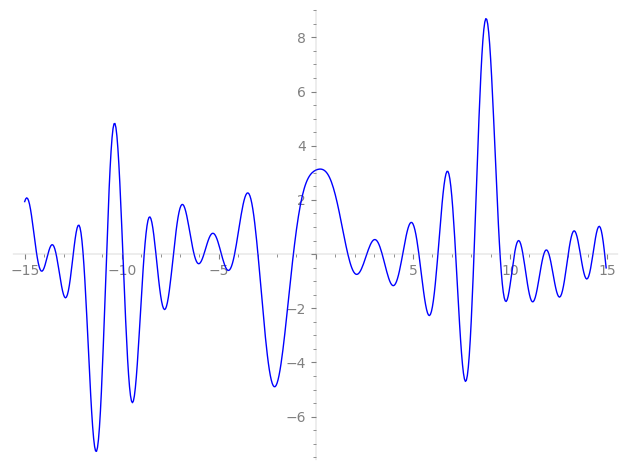| L(s) = 1 | + (1.47 + 1.47i)2-s + 2.34i·4-s + (0.834 − 2.07i)5-s + (0.188 − 0.188i)7-s + (−0.502 + 0.502i)8-s + (4.28 − 1.82i)10-s − 2.92i·11-s + (0.0612 + 0.0612i)13-s + 0.556·14-s + 3.20·16-s + (1.41 + 1.41i)17-s − 1.33i·19-s + (4.85 + 1.95i)20-s + (4.30 − 4.30i)22-s + (0.707 − 0.707i)23-s + ⋯ |
| L(s) = 1 | + (1.04 + 1.04i)2-s + 1.17i·4-s + (0.373 − 0.927i)5-s + (0.0713 − 0.0713i)7-s + (−0.177 + 0.177i)8-s + (1.35 − 0.577i)10-s − 0.880i·11-s + (0.0169 + 0.0169i)13-s + 0.148·14-s + 0.800·16-s + (0.342 + 0.342i)17-s − 0.306i·19-s + (1.08 + 0.436i)20-s + (0.917 − 0.917i)22-s + (0.147 − 0.147i)23-s + ⋯ |
\[\begin{aligned}\Lambda(s)=\mathstrut & 1035 ^{s/2} \, \Gamma_{\C}(s) \, L(s)\cr =\mathstrut & (0.893 - 0.448i)\, \overline{\Lambda}(2-s) \end{aligned}\]
\[\begin{aligned}\Lambda(s)=\mathstrut & 1035 ^{s/2} \, \Gamma_{\C}(s+1/2) \, L(s)\cr =\mathstrut & (0.893 - 0.448i)\, \overline{\Lambda}(1-s) \end{aligned}\]
Particular Values
| \(L(1)\) |
\(\approx\) |
\(3.101804741\) |
| \(L(\frac12)\) |
\(\approx\) |
\(3.101804741\) |
| \(L(\frac{3}{2})\) |
|
not available |
| \(L(1)\) |
|
not available |
\(L(s) = \displaystyle \prod_{p} F_p(p^{-s})^{-1} \)
| $p$ | $F_p(T)$ |
|---|
| bad | 3 | \( 1 \) |
| 5 | \( 1 + (-0.834 + 2.07i)T \) |
| 23 | \( 1 + (-0.707 + 0.707i)T \) |
| good | 2 | \( 1 + (-1.47 - 1.47i)T + 2iT^{2} \) |
| 7 | \( 1 + (-0.188 + 0.188i)T - 7iT^{2} \) |
| 11 | \( 1 + 2.92iT - 11T^{2} \) |
| 13 | \( 1 + (-0.0612 - 0.0612i)T + 13iT^{2} \) |
| 17 | \( 1 + (-1.41 - 1.41i)T + 17iT^{2} \) |
| 19 | \( 1 + 1.33iT - 19T^{2} \) |
| 29 | \( 1 - 4.81T + 29T^{2} \) |
| 31 | \( 1 - 4.71T + 31T^{2} \) |
| 37 | \( 1 + (1.78 - 1.78i)T - 37iT^{2} \) |
| 41 | \( 1 + 2.01iT - 41T^{2} \) |
| 43 | \( 1 + (5.51 + 5.51i)T + 43iT^{2} \) |
| 47 | \( 1 + (-7.37 - 7.37i)T + 47iT^{2} \) |
| 53 | \( 1 + (3.62 - 3.62i)T - 53iT^{2} \) |
| 59 | \( 1 - 5.14T + 59T^{2} \) |
| 61 | \( 1 + 13.3T + 61T^{2} \) |
| 67 | \( 1 + (4.95 - 4.95i)T - 67iT^{2} \) |
| 71 | \( 1 - 7.80iT - 71T^{2} \) |
| 73 | \( 1 + (8.46 + 8.46i)T + 73iT^{2} \) |
| 79 | \( 1 - 5.81iT - 79T^{2} \) |
| 83 | \( 1 + (-0.630 + 0.630i)T - 83iT^{2} \) |
| 89 | \( 1 + 2.89T + 89T^{2} \) |
| 97 | \( 1 + (1.69 - 1.69i)T - 97iT^{2} \) |
| show more | |
| show less | |
\(L(s) = \displaystyle\prod_p \ \prod_{j=1}^{2} (1 - \alpha_{j,p}\, p^{-s})^{-1}\)
Imaginary part of the first few zeros on the critical line
−9.942036423486636574490024728341, −8.844326309292889878938688306274, −8.239276084996715380713364497934, −7.33679161672746177323075724587, −6.27524648024761720488684801967, −5.76657314496706452891191539381, −4.86807527472799888732598786677, −4.18814738016926125147242042691, −2.98554868516167537725105876097, −1.16023798687874120025195900758,
1.64527094284043125908305879272, 2.62164790122568314039909733894, 3.41314659984578841356763046565, 4.47059527260906548458844864496, 5.30418023675398296577600438677, 6.28464686394907813719391008833, 7.19875302761602364869767415777, 8.144316991208599497340672163763, 9.484865526951189000458888924019, 10.22560386526777948404276172409

